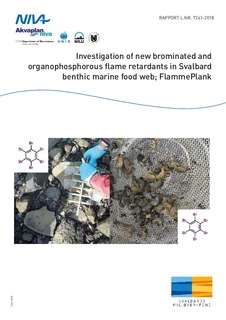| dc.contributor.author | Carlsson, Pernilla Marianne | |
| dc.contributor.author | Nizzetto, Pernilla Bohlin | |
| dc.contributor.author | Vrana, Branislav | |
| dc.contributor.author | Varpe, Øystein | |
| dc.contributor.author | Sobotka, Jaromír | |
| dc.contributor.author | Borgå, Katrine | |
| dc.date.accessioned | 2018-04-12T06:17:17Z | |
| dc.date.available | 2018-04-12T06:17:17Z | |
| dc.date.created | 2018-04-11T13:17:32Z | |
| dc.date.issued | 2018 | |
| dc.identifier.isbn | 978-82-577-6996-3 | |
| dc.identifier.issn | 1894-7948 | |
| dc.identifier.uri | http://hdl.handle.net/11250/2493735 | |
| dc.description | Project manager Pernilla Carlsson | nb_NO |
| dc.description.abstract | The aim of this pilot-study was to use silicone rubber-based passive samplers to measure novel brominated flame retardants (nBFRs), polybrominated diphenyl ethers (PBDEs) and dechlorane plus (DP) in seawater and air around Longyearbyen as well as investigate the presence of those compounds in sediment and biota (amphipods, Gammarus spp.) nearby Longyearbyen. Passive samplers require no electricity and provide an integrated picture of the levels of the targeted compounds over time. The results were combined with the sampled sediment and Gammarus spp. to assess concentrations in the environment. Out of all substances under study, PBDE-47 and -99, α- and β- tetrabromoethylcyclohexane (TBECH), syn- and anti-DP were detected in all investigated matrices. Freely dissolved water concentrations of ΣDPs (3 pg/L) were in line with recent Arctic studies, while ΣPBDEs (3 pg/L) were comparable to urban rivers in southern Norway. Nevertheless, for some compounds, especially the lighter and most volatile ones, long-range transport is most likely a more important contribution to observed levels than local sources. For other compounds, e.g. PBDEs, local sources might still play a role for the load of contaminants into the surrounding environment. The present study is the first to report a suit of nBFRs and DPs in Arctic benthic fauna. Many of the nBFRs and DPs were detected in sediment and in the amphipods. We recommend further studies with respect to measurements of concentrations over time, and in other species as well, to better understand whether the nBFRs and DPs are common in the marine environment on Svalbard. We recommend that local sources of flame retardants in remote areas receive more attention in the future. | nb_NO |
| dc.description.sponsorship | Svalbard miljøvernfond | nb_NO |
| dc.language.iso | eng | nb_NO |
| dc.publisher | Norwegian Institute for Water Research | nb_NO |
| dc.relation.ispartof | NIVA-rapport | |
| dc.relation.ispartofseries | NIVA-rapport;7261 | |
| dc.rights | Navngivelse-Ikkekommersiell-DelPåSammeVilkår 4.0 Internasjonal | * |
| dc.rights.uri | http://creativecommons.org/licenses/by-nc-sa/4.0/deed.no | * |
| dc.subject | Amfipoder | nb_NO |
| dc.subject | Amphipods | nb_NO |
| dc.subject | Passiv prøvetaking | nb_NO |
| dc.subject | Passive sampling | nb_NO |
| dc.subject | Nye brominerte flammehemmere | nb_NO |
| dc.subject | New brominated flame retardants | nb_NO |
| dc.subject | Svalbard | nb_NO |
| dc.title | Investigation of new brominated and organophosphorous flame retardants in Svalbard benthic marine food web; FlammePlank | nb_NO |
| dc.type | Research report | nb_NO |
| dc.description.version | publishedVersion | nb_NO |
| dc.rights.holder | Norwegian Institute for Water Research | nb_NO |
| dc.subject.nsi | VDP::Matematikk og naturvitenskap: 400 | nb_NO |
| dc.subject.nsi | VDP::Mathematics and natural scienses: 400 | nb_NO |
| dc.source.pagenumber | 29 | nb_NO |
| dc.source.issue | 7261 | nb_NO |
| dc.identifier.cristin | 1578796 | |
| dc.relation.project | 16090 | nb_NO |
| cristin.unitcode | 7464,30,21,0 | |
| cristin.unitname | Miljøkjemi | |
| cristin.ispublished | true | |
| cristin.fulltext | original | |

